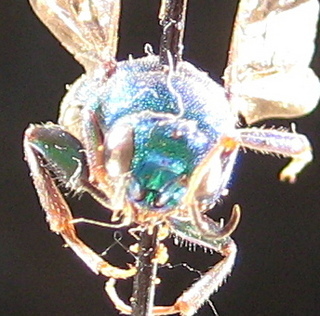
Native Bee Inventory and Monitoring Lab; Photographer: Josh · 9
Hedychrum violaceum, face |
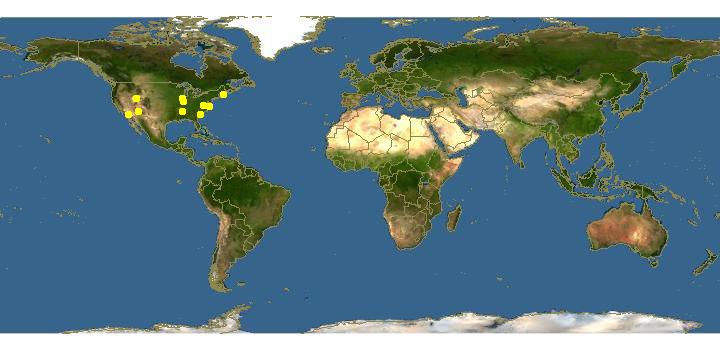
Click on map for details about points.
|
80x5 -
240x3 -
240x4 -
320x1 -
320x2 -
320x3 -
640x1 -
640x2
Set display option above.
Click on
images to enlarge. |
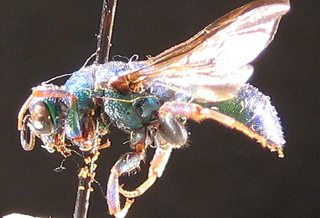
Native Bee Inventory and Monitoring Lab; Photographer: Josh · 9
Hedychrum violaceum |
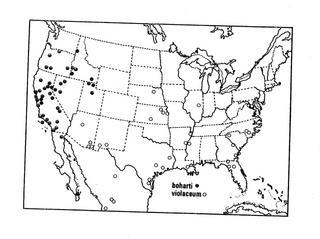
R. M. Bohart and L. S. Kimsey, 1982 · 9
Hedychrum violaceum |
|
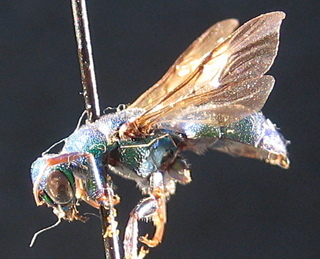
Native Bee Inventory and Monitoring Lab; Photographer: Josh · 1
Hedychrum violaceum |
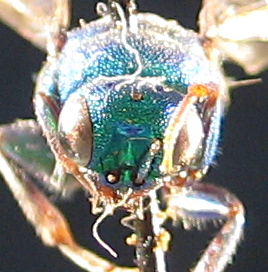
Native Bee Inventory and Monitoring Lab; Photographer: Josh · 1
Hedychrum violaceum, face |
|
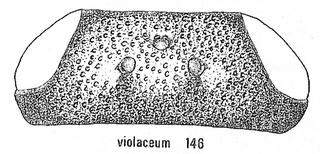
R. M. Bohart and L. S. Kimsey, 1982 · 1
Hedychrum violaceum, head |
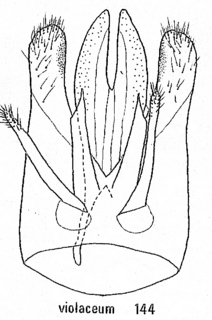
R. M. Bohart and L. S. Kimsey, 1982 · 1
Hedychrum violaceum, male genitalia |
|
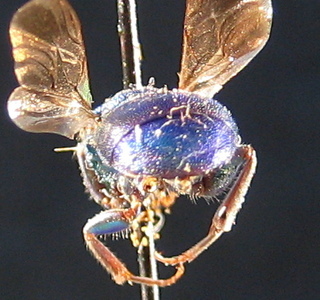
Native Bee Inventory and Monitoring Lab; Photographer: Josh · 1
Hedychrum violaceum, tail |
|
Overview |
Taken from:
R. M. Bohart and L. S. Kimsey. 1982. A Synopsis of the Chrysididae in America North of Mexico.
Hedychrum violaceum Brulle
(Figs. 144, 146, 154, 157)
Hedychrum violaceum Brulle1846:5. Neotype male (here designated), Cape May, N. J., July 27, 1938, Whitmer Stone (UCD).
Hedychrum louisianiae Norton 1879:238. Lectotype male, La. (ANSP).
Neotype male: length 10 mm, forewing length 7 mm; body, scape, pedicel and legs except for tarsi green with bluish and violaceous reflections; apical margin of T-I-III, T-II medially and T-III basally violet; tarsi and wings except for median and submedian cells brown; wings veins and sterna dark brown; median and submedian wing cells light smoky brown; punctation of head finer than punctation of pronotum, punctation of lateral margins of abdomen much coarser than pronotum, punctures of sublateral margin of T-I coarse (more than 0.25 PD apart) (fig. 154) and not contiguous, impunctate shiny area laterad of lateral ocellus subequal to 1.0 LOD, midocellus with a deep furrow from its ventral margin; scapal basin dorsal margin with a broad pit; body and legs covered with white hair, mostly 1.0 MOD long, hindtibial pit twice as long as wide, midtibial pit 2. 5 times as long as wide, both restricted to apical third of tibia; male genitalia (fig. 144), cuspis longer than digitus, distal arm of paramere symmetrically rounded apically.
Female: Similar to male. S-III apicomedial tooth deeply notched, subbasal sulcus extending five sixths of distance to midline.
Distribution: Arizona to Florida In the south and Nebraska to Connecticut in the north. Specimens were collected from June to September.
Material examined: 99 males, 81 females.
Discussion: This large species is close to wiltii and confusum by the brown sterna and coarse punctation. H. confusum is distinct by having contiguous punctures on the lateral margin of T-I and by its smaller size (5-7 mm versus 8-11 mm). H. wiltii is separated by its black body hair versus the light brown body hair of violaceum. In
addition, violaceum has lighter colored median and submedian cells in the forewing compared to the apical cells in that wing. The wings of wiltii are evenly brown. I have established a neotype of this species because the type specimen is apparently lost and the identity of this species has been in a state of confusion since Aarons work published in 1885. In this work he synonymized five species under the name violaceum, including asperum Brulle, which is a Holopyga. Aarons concept of violaceum was used by most workers. As a result most specimens of Hedychrum were labeled violaceum. To help resolve this problem, I felt it necessary to designate a neotype that closely fits Brulles description.
Hedychrum Latreille
Larry D. French
Hedychrum Latreille 1802:317. Generotype Chrysis lucidula Fabricius 1775 (Sphex nobilis Scopoli 1763), original designation.
Diagnosis: Tarsal claw with a single subsidiary tooth, appearing bifid (fig. 134), hindtibia (in some species also midtibia) with a pit or depression on posterior surface towards apex, medial vein weakly curved (fig. 135), frons along inner eye margins and scutellum with rather even and close punctation, scapal basin with strong transverse ridging, RS stub extending apicad at least as far as stigma, median cell of forewing setose, female sternum Ill with a subbasal sulcus extending from lateral margin at least halfway to midline (fig. 150) and with an apicomedial tooth (in all New World species) (fig. 150).
Discussion: Hedychrum of North America as treated here contains nine species. Most are rather common, medium sized greenish to bluish wasps found in mountain areas associated with sandy soils. A total of 3, 550 specimens were examined for this study.
Members of this genus are known to be nest parasites of sphecid wasps of the tribe Cercerini that provision their nests with adult curcullonids. However, little has been published on the biology of Hedychrum beyond a few records of association with the hosts.
The most recent synoptic works on Hedychrum were by Aaron (1885) and Norton (1879), both of whom were hindered by having too few specimens and an unclear concept of the genus. Therefore, they had problems with the distinction between Hedychrum and other closely related genera.
It is now clear that the hindtibial pit, bifid tarsal claws and sub- basal sulcus of sternum III make Hedychrum easy to distinguish. One closely related genus that might pose a problem in identification is the recently described Hedychreides Bohart from western North America. This wasp has bifid tarsal claws but it lacks the well-defined hindtibial pit and transverse ridging in the scapal basin.
Sex determination in most elampine genera is a difficult task at best. Hedychrum is an exception to this rule with three useful characters for sexing individuals. Females have an apicomedial tooth and a subbasal sulcus on sternum UI (fig. 150), whereas males have none (fig. 151). Also, the anterior face of the hindfemur in females is smooth and shiny green, whereas in males it is reticulate and dull brown.
Male genitalia in most chrysidids are useful for species distinction. However, in Hedychrum their value appears to be limited. In a few species there are slight differences in the shape of the distal end of the paramere and in one species (spiloventer) the cuspis is club shaped.
Key to Hedychrum
1. S-II-III extensively green to blue
2
S-II-III brown, except S-II or III may have a small spot of green to blue medially
4
2. Thoracic dorsum green to gold, contrasting with blue to blue green of propodeum, body length 9-11 mm
cupricolle Cresson
Body uniformly green to blue, less than 9 mm long
..3
3. Hindtibial hair and T-III apical hair black mostly 1.5 MOD long, T-I smooth subbasally fig. 158), female S-III apical tooth not bibbed (fig. 150)
..nigropilosum Mocsary
Hindtibial hair white to light brown, T-III apical hair white to black, both T-III
apical hair and hindtibial hair mostly 1 MOD long, T-I basally with three or more longitudinal carinae (fig. 159), female S-III apical tooth bibbed (fig. 149)
parvum Aaron
4. Body hair black, sterna brown, body blue to bluish purple, male pedicel brown
.wiltii Cresson
Body hair white to light brown, never black; sterna brown or sometimes with a medial green spot; body green to greenish blue; male pedicel green to blue
5
5. Forefemur with distinct subbasal angle (fig. 136), hindtibial pit almost reaching base
of tibia (fig. 142)
boharti French
Forefemur rounded subbasally (fig. 137), hindtibial pit restricted to apical fourth
of tibia (fig. 140)
..6
6. Hindtibial pit very small (fig. 141), abdomen with brown to violet spot dorsomedially
.punctum French
Hindtibial pit not reduced (fig. 140), abdomen uniformly green to blue
.7
7. Tergum I with sublateral punctures contiguous, less than 0.25 PD apart (fig. 153), and more than four well developed carinae running from base halfway to summit (fig. 156)
.confusum Buysson
Tergum I with sublateral punctures not contiguous, more than 0.25 PD apart (figs. 154 and 155), and four or fewer carinae running from base halfway to summit (fig. 157)
.8
8. Body length 8-10 mm, sternum II brown, impunctate area laterad of lateral ocellus greater than 1.0 LOD across (fig. 146), head in dorsal aspect 2.5 times as wide as long (fig. 146)
violaceum Brulle
Body length 4-5 mm, sternum II with green spot medially, impunctate area laterad of lateral ocellus less than 1.0 LOD across (fig. 147), head in dorsal aspect twice as wide as long (fig. 147)
.spilovener French
|
|
| Supported by | |
Updated: 2024-04-19 07:31:34 gmt
|